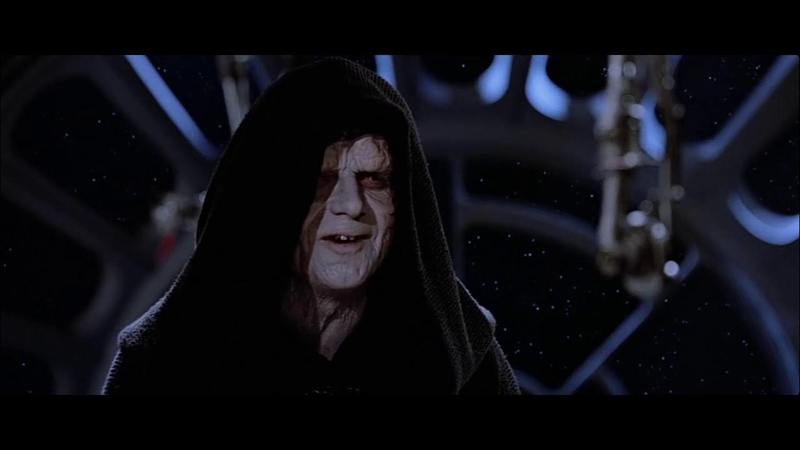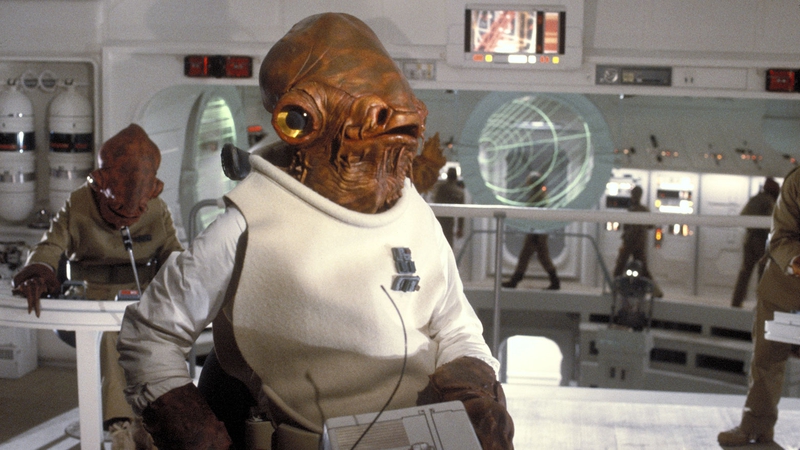Monsters, aliens, and bizarre creatures. That strapline has famously set out FANGORIA's ethos since its first issue, and, as it happens, it also applies to a set of films from a galaxy far, far away, with the most monster-centric of them all celebrating its fortieth anniversary this May. So strap yourself in while we jump to lightspeed and examine the breathtakingly bizarre monsters of Return of the Jedi.
It was always apparent that George Lucas was obsessed with monsters. From the garbage-dwelling Dianoga in Star Wars to the brutal Hoth Wampa in The Empire Strikes Back, the series has always made time for close encounters of the beastly kind. When it came time to make the third film, it was no surprise that Jedi served as a showcase for the legendary artists that made up Industrial Light and Magic's creature shop. Artists such as Stuart Freeborn, who created the ape makeup for Stanley Kubrick's "Dawn of Man" sequence in 2001: A Space Odyssey, Phil Tippett, who animated the gigantic AT-AT walkers in The Empire Strikes Back, and many other names who would become future legends, like Chris Walas (The Fly) and Bob Keen (Hellraiser).
Astonishingly, the crew was creating incredible work within multiple disciplines and strict deadlines, with special effects makeup still in its relative infancy. Rick Baker (who worked on Star Wars' famous cantina scene) had recently won an Oscar for An American Werewolf in London, and artists like Dick Smith and Tom Savini were constantly pushing the envelope, but with the film's scale, a range of methods was needed. People in masks were one thing, but there was also puppetry in different scales and animatronic work.
"It was running fast and furious," Phil Tippett said in J.W. Rinzler's The Making of Return of the Jedi, "and one of the prime motivating factors which kept us going was simply fear—fear of our work being substandard to Rick Baker's creations or Rob Bottin's handiwork. That was really scary!"
A big difference between Jedi and its predecessors was that its monsters would not be relegated to quick shots or background characters. These were to be front and center, with the first act a veritable smorgasbord of creature creations. It was like Ray Harryhausen had organized Coachella, with Jabba the Hutt headlining the show.

The film's opening crawl describes Jabba as a "vile gangster," with the preceding films building him up through dialogue. The creature had to match that. Lucas thought of the character as an alien equivalent of Marlon Brando in The Godfather, and Tippett won his approval by making Jabba a loathsome giant slug. Three puppeteers were placed inside Jabba, all performing different functions such as his head, mouth, arms, and tail, and the result is a wonderful fully-fledged character that exudes menace and a kind of twisted charisma.
Of course, Jabba can't move around much at his size, but why should he? He's the boss and has a palace full of crazy aliens ready to do his bidding, with the pig-like Gamorrean guards, Klaatu's henchmen, Barada, and Nikto, and the infamous Yak Face (Saelt-Marae). To quote Obi-Wan Kenobi, Jabba's palace is a hive of scum and villainy, and it's an exceedingly dangerous place. Say the wrong thing and you'll find yourself barrelling through a trapdoor into the giant dungeon underneath the main hall, as Luke Skywalker did. However, it's less of a jail and more of a pen for Jabba's pet—the ferocious Rancor.

The Rancor sequence is the high point for monster fans in the film, as our intrepid Jedi-elect is faced with a towering, slavering creature that wants to do nothing more than gobble him up. The scene is reminiscent of many Harryhausen pictures and the one that started it all: King Kong, with Mark Hamill replacing Fay Wray. "In shooting that sequence one of my biggest acting dreams came true," the actor said. "I actually got to be held in a giant rubber hand."
The original idea for shooting the Rancor was inspired by another giant cinematic legend, Toho's Godzilla, but things didn't work out the way Lucas and Co intended. "George was adamant that we were going to do it as a man in a suit," said Tippett. "It was gonna be like a really cool Godzilla. I actually had to wear this suit and try and perform in this thing. But it was just this, blah, this big, dumb thing that was a cross between a bear and a potato."
The final creature was realized as a puppet in a miniature set, but to make it appear as a gigantic monster on screen, they had to shoot at higher camera speeds of seventy-two and ninety-six frames per second. "It was a crazy way of working," Tippett said, "because the monster has to walk into a room, turn around and roar, so it's like a four-second shot, but you've only got a second to shoot it. But it was interesting to think on your feet as opposed to thinking like a stop-motion animator usually thinks—like a snail."
The shoot was supervised by Dennis Muren, one of Jedi's three visual effects supervisors who had previously co-directed the low-budget monster epic Equinox in 1970. Because he was steeped in monster movie lore like Tippett, both found it easy to work together, with a shorthand both possessed. "Dennis really understands lighting and scale, and contributes a great deal to a shot's character," Tippett said. "We also used a number of Ray Harryhausen's classic movements. 'What are we going to do now?' we would ask. 'Let's move it like the Cyclops,' someone would suggest. And everyone would instantly know what to do."
Return of the Jedi also properly introduced the real villain of the saga: The Emperor, previously only seen as a hologram. Actor Ian McDiarmid provided a snarling performance that efficiently conveyed the character's intelligence and malevolence, amplified by superb makeup by Freeborn and trainee Nick Dudman, who had previously worked on Tony Scott's The Hunger. "Our intention," Tippett said, "was to create through makeup an age-wrinkled face with a large split cranium that was beginning to grow apart. We felt the Emperor should be ancient, not old, so the quality of the wrinkle was important. The enlarged skull was a foam latex appliance that carefully joined the actor's face. Black and rotting teeth added an extra wild quality that we hoped would enhance the Emperor's treacherous dialogue."

The Rebel Alliance also featured several creatures on the good side, with the iconic Admiral Ackbar standing out amongst the fairly ugly crowd. But it's the monsters our heroes have to face that the film is known for. Even though it's been forty years, Jabba the Hutt, the Rancor, and the other beasties of the picture still hold up not only as superior examples of makeup, puppetry, and visual effects but also as characters in their own right.

But there's a key thing that audiences have taken away from Return of the Jedi, and it's that everybody loves monsters. Even—or especially—when they're the grossest and most fearsome around, as seen when the Rancor's keeper weeps over its death at the hands of Luke Skywalker. " I like the idea that everyone loves someone. And even the worst, most horrible monster you can imagine was loved by his keeper," George Lucas said. "And the Rancor probably loved his keeper."






